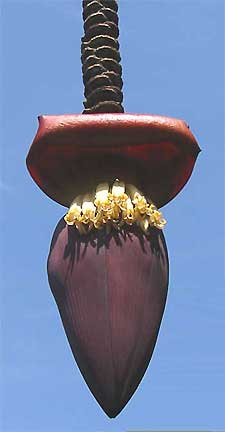
Excerpts from Jim Conrad's
Naturalist Newsletter
from the April 14, 2008 Newsletter issued from near Venustiano Carranza in the Central Valley of Chiapas, MÉXICO
BANANA PLANT FIBERS
Seeing the Streak-backed Oriole so easily dislodging one fiber after another from a banana tree, I went to see if I could do it. Once I began paying attention I decided that lots of birds must have been pulling out lots of fibers to cause the trees' leaves to be so tattered. You can see a really tattered blade below:
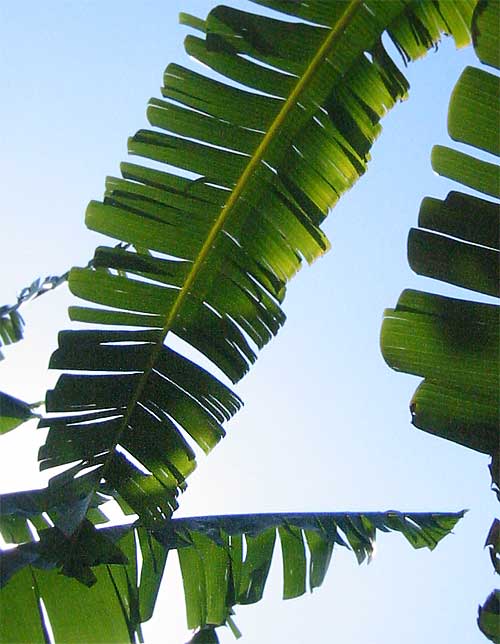
In that picture notice that here and there entire sections of leaf appear to have been removed. I felt sure that these were animal-made, but then I looked closely at how fibers were arranged in the leaf:

The fibers are actually parallel-running veins conducting water and the products of photosynthesis up and down the blade. Splits appear to develop naturally beside certain larger veins, then continue into the blade's midvein, angling toward the trunk. To extract a fiber I found it easiest to start tugging where the split enters the midrib and from what I can see orioles think the same. Also I found that fibers in old, dry leaves are too brittle, but those in young leaves are too weak. A leaf old enough to already have lots of splits in it is just right.
I suspect that orioles and other animals also use fibers from old banana-tree "trunks" (actually leaf petioles), for they are very fibrous, as shown below:
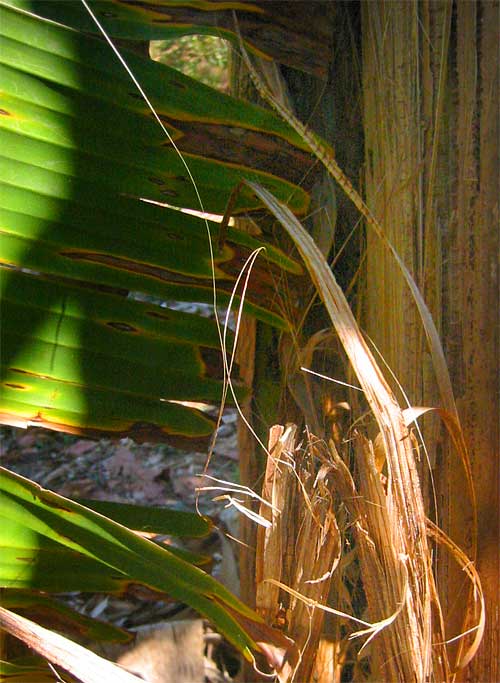
In fact, Nature is full of useful fibers. Often I see birds gathering them from palms. Remember back at Pollys Bend in Kentucky how House Finches gathered fiber from Paper Mulberries, and other times I've mentioned the strong fibers in nettles.
from the April 14, 2008 Newsletter issued from near Venustiano Carranza in the Central Valley of Chiapas, MÉXICO
CUTTING BANANA LEAVES
Banana trees are good for more than fibers and bananas. The other day Andrés took me along to cut banana leaves whose blades later would be fashioned into flat squares in which tamales would be wrapped for steaming.
Arriving at the plantation Andrés removed from his side-bag a short, curved, steel blade with the cutting edge on the inside curve. This he fitted onto a long pole, and then he proceeded to cut banana leaves. It was a simple operation of positioning a banana-leaf petiole inside the curved blade, and jerking downward. The six-foot blade would then flutter to the ground.
Once he'd cut about twenty blades he began gathering dry leaf-clutter from beneath trees and piling it into a heap. "It's too cold, so we need a fire," he joked in the 97° heat. We'd just been joined by our friend Pancho, who'd come to cut bananas for his family, and he, lying on the ground watching us, laughed so hard he had to hold his stomach. Then Andrés set fire to the dry leaf-trash and undertook the operation you can see taking place, with Pancho in the background, below:

Andrés knew I didn't understand why he was doing this but he didn't offer a word. Instead, after he'd finished he cut a small square of unfired banana leaf and crumpled it in his hand. It was so brittle that it crunched and tore. Then he cut a similar square of a fired leaf, crumpled it, and it made no sound, didn't tear, but behaved like a moist cloth. All was clear.
Pancho found the notion that a big, smart gringo such as myself wouldn't know all this simple stuff so funny that once again he broke into hysterics, actually rolling on the ground. Though in our community, unlike so many others in the area, drunkenness isn't a problem, I thought that Pancho surely was drunk. But, no, later I could see that he was just happy to lie on the ground in the shade with a good breeze blowing, watching his friends work as he poked good-natured fun at them. The man was simply happy!
Andrés began cutting the leaves' flat side-blades from their stiff midribs while I folded the resulting sheets per his instructions. Several time Andrés asked, "It's interesting stuff, isn't it Jim?" and I'd say yes, and Pancho would laugh even harder than the last time.
You can see what Andrés looked like as I followed him home from the banana plantation, flat sheets of banana leaf compactly rolled and held in his headband gear, in his mecapal, over his shoulder, below:
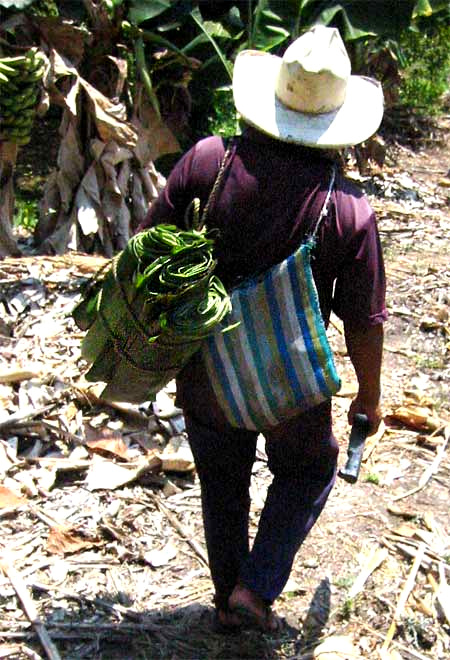
Sunday morning Andrés brought me some tamales wrapped in our banana leaf sections. Tamales are pillow-like packages of cooked corn stuffed with various ingredients. Mine were filled with a bean/tomato mix and wrapped in spicy leaves of Piper auritum, sometimes called Hoja Santa but here called Mu-mu. Then the Mu-mu package was wrapped in sheets of our banana leaves. During steaming the green Mu-mu leaf softens and blends with the corn package so I just bit through the Mu-mu as if it weren't there. The tamale was delicious and the Mu-mu flavor was a nice touch. You can see my tamale, green banana leaf at the left in the picture, the Mu-mu-encased tamale at the right, below:

from the May 12, 2008 Newsletter issued from near Venustiano Carranza in the Central Valley of Chiapas, MÉXICO
BANANA TREE FLOWERS
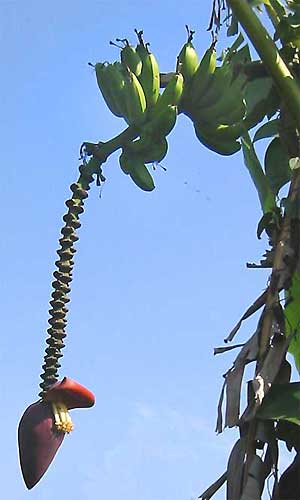
The picture above shows a stalk of ripening bananas. Or, more technically, it shows a drooping, spike-type cluster of flowers, or inflorescence, with female ovaries maturing into bananas at the base of the spike (top in the picture) and male flowers subtended by broad, colored bracts at the spike's tip (bottom in the picture).

The above picture shows fifteen or so functionally male flowers that will never produce bananas, just pollen. The peeling-back, hoodlike thing above them is a bract, or modified leaf. The stem, or rachis, at the top of the picture shows many scars of previous bracts, so over time there's been a lot of male flowers shedding pollen from their anthers, then falling off, along with their bracts.
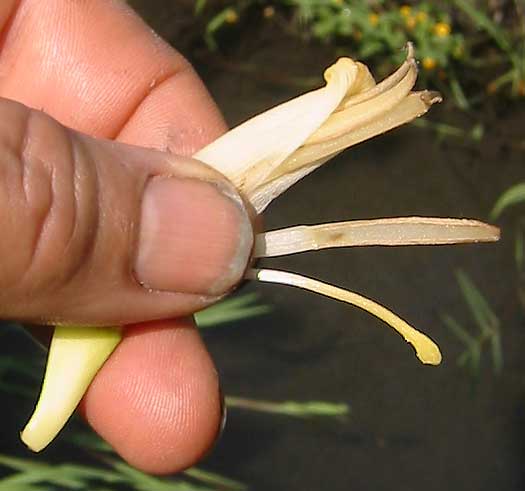
Above you can see a male flower. The flat, long item with powdery lines along its margins, extending from the center of my thumbnail, is a stamen. The powdery lines are pollen issuing from elongate anther sacs along the anther's margins. The blunt, yellow-tipped thing below that is a sterile staminode, probably evolved to give pollinators something to hold onto as they pull themselves into the flowers' throats dusting themselves with pollen.
So, banana flowers are unisexual, though when they first start developing sometimes you can find stamen- bearing flowers with ovaries. However, in flowers whose stamens eventually produce pollen, the ovaries abort and don't develop into bananas.
from the January 29, 2012 Newsletter issued from Hacienda Chichen Resort beside Chichén Itzá Ruins, central Yucatán, MÉXICO
FEMALE BANANA FLOWERS
Earlier we looked at individual male flowers; now let's look closer at female flowers. Some are shown below:
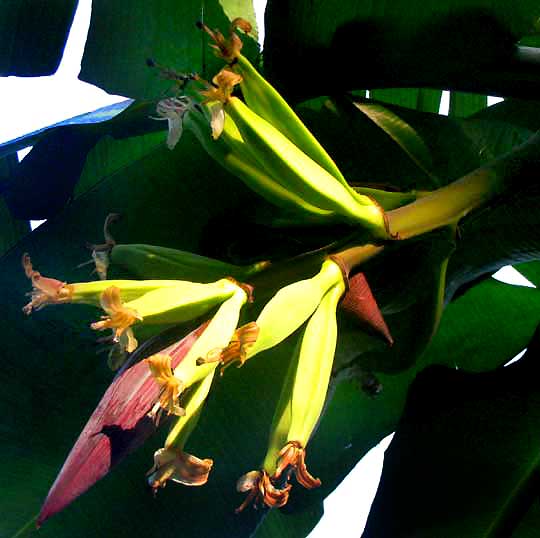
In that picture the flower cluster is just beginning to open up, revealing female flowers at the base of the cluster. Until well after this stalk's female flowers have ceased being receptive for pollination, male flowers will remain immature and hidden beneath the numerous overlapping purple bracts forming the spearhead at the picture's lower left. By having male and female flowers maturing at different times, plants can avoid pollinating themselves.
 In most flowers, the calyx, corolla and male stamens arise at the base of the female pistil, as shown for the "superior ovary" in the diagram provided at the right. There the "inferior ovary" at the left shows the case with Banana flowers, which have the calyx, corolla and male stamens arising atop the female ovary. Another way of saying that is that the immature bananas in our pictures are inferior ovaries. You can see what's atop a typical banana ovary below:
In most flowers, the calyx, corolla and male stamens arise at the base of the female pistil, as shown for the "superior ovary" in the diagram provided at the right. There the "inferior ovary" at the left shows the case with Banana flowers, which have the calyx, corolla and male stamens arising atop the female ovary. Another way of saying that is that the immature bananas in our pictures are inferior ovaries. You can see what's atop a typical banana ovary below:
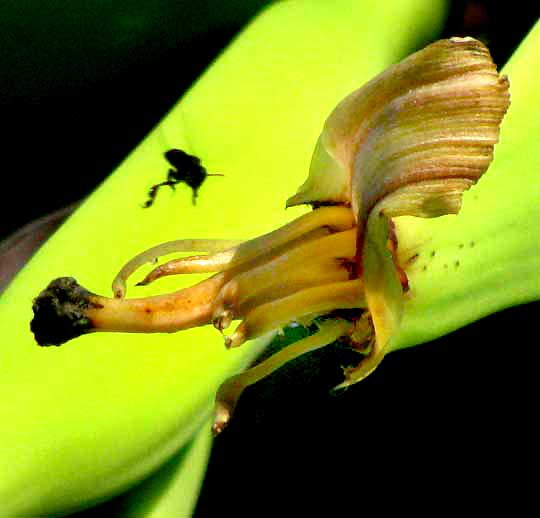
The ribbonlike, striated item curving toward the picture's top, right is the calyx, which started out as a cylinder, then split down one side and curled back, and soon will fall off. Earlier on the other side there was a similar ribbonlike thing; that was the corolla, and it's already fallen off. The pale, slender, fingerlike objects arising at the base of the single, thicker, dark-headed item are sterile stamens. In the distant past when the Banana's ancestors were evolving, these stamens would have been fertile, producing pollen, but now, in these female flowers, they're vestigial, like the appendix on the human large intestine. The thick-based, black-headed item pointing at the left side of the picture is the blackish stigma, where pollen germinates, atop the ovary's "neck," the style.
Actually, these sexual parts are all rather useless to the cultivated Banana, since Banana genes have been so scrambled during centuries of domestication by humans that Banana flowers no longer produce fruits with viable seeds. Those tiny, brown, soft, sandgrain-like items inside a sliced-open banana fruit are aborted ovules -- aborted because the female sex germ inside each ovule never was fertilized by a male sex germ from a pollen grain.
If humans were to disappear, and thus no longer transplant vegetative sprouts arising at the bases of Banana "trees," there'd be no more Banana trees producing banana fruits as we know them. Some wild ancestral Banana species still able to reproduce sexually and make viable seeds would continue to survive, however.
from the April 21, 2007 Newsletter issued from Sierra Gorda Biosphere Reserve, QUERÉTARO, MÉXICO
COSTILLÓN BANANAS

The other day my friend Marina brought me some bananas she and her husband grew at their mountain rancho. Thick-skinned, thick-bodied, six-inch long fruits that instead of being round in cross-section were angular, they were of a type I've never seen in a North American market. Of course, above that's Marina and her bananas, which she called Costillones or "Big-ribbers," with Camila the dog in the background.
I'm never surprised to see new types of bananas because I know there are lots of them. At the bottom of the page at http://mgonline.com/articles/banana.aspx you can find a list of 117 named banana varieties.
Marina's Costillones have a somewhat spongy flesh and a bland, slightly sour taste. They're similar to those I've seen elsewhere that are meant to be baked, not eaten raw, but Marina says that here Costillones are eaten raw. My friend Julio says the best way to eat them is in a licuado -- blend them in milk, add honey and cinnamon, and come up with something like a banana smoothie.
from the February 7, 2016 Newsletter issued from Hacienda Chichen Resort beside Chichén Itzá Ruins; limestone bedrock; elevation ~39m (~128ft), N20.675°, W88.569°; central Yucatán state, MÉXICO
THE BANANA TREE'S STEM
So many things are said about banana plants above that I figured we'd covered the subject. However, this week I was exploring a part of the woods where the gardeners had dumped an old banana tree they'd thinned from the plantation, and when I saw the tree's cut-through, foot-thick trunk, I just had to sit and study the matter. Below, you can see what I saw:
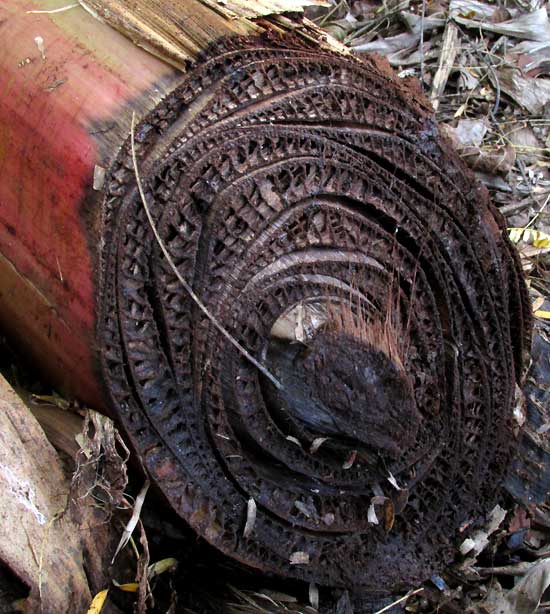
First of all, we need to be clear that what normally is called a banana tree is actually a short-lived, herbaceous shoot off a perennial rhizome that lives for years underground. The subterranean rhizome issues shoots that grow tall fast, flower and fruit, and then die, while the rhizome lives on. Maybe the best way to describe the "banana tree" is as a tree-like perennial herb. The trunk or stem of the tree-like perennial banana shoot is a false stem technically known as a "pseudostem."
So, in our picture you can see that a banana plant's pseudostem mostly consists of overlapping sections that in cross-section appear slenderly crescent-shaped. These are the banana leaf's tightly packed, overlapping leaf stems, or petioles, flattened at their edges into sheaths that partly wrap around other petioles. These leaf bases nest within one another in a spiraling manner. The solid part in the cross-section's center is the flower stalk extending up through the pseudostem, terminating at its top with a cluster of flowers and/or banana fruits.
Our picture shows that each overlapping leaf sheath displays interesting structural features, shown in more detail below:

Besides the sheaths conspicuous cross-walls and cells between the cross-walls, notice the fibrous nature of the sheaths' skins. On our banana page we show that these fibers are quite strong.
The remarkable thing is that even though the banana plant's pseudostem is fleshy and consists mostly of water, it's strong enough to support a bunch of banana fruits weighing well over a hundred pounds (50 kg). Also, banana plants are famously able to withstand strong winds. During hurricanes, their leaves and stems flap and gyrate, but usually don't break or get flattened. Seeing our pesudosem's inner architecture, I figured that I was witnessing some sophisticated engineering, so I looked into the matter.
At https://academic.oup.com/jxb/article/51/353/2085/581412 I freely downloaded a research paper published in 2000 in the Journal of Experimental Botany entitled "The functional morphology of the petioles of the banana, Musa textilis," by AR Ennos and others.
That paper makes the point that a general rule in engineering is that when rigid supports are slender, under heavy weights they tend to buckle, but when features are added to deal with the buckling, rigidity is lost and not much weight can be supported. Banana pseudostems are slender, rigid and resist buckling, so the authors thought it was worth trying to figure out how they did it.
The researchers, after extensive consideration of the banana plant's structural curiosities, ended their paper with, "In conclusion, it is the combination of the many distinctive features of the banana petiole into a clever integrated design that seem to confer its ability to be both rigid and deform reversibly downwind in gales."
In other words, if you want to build a slender support that's rigid enough to bear heavy weight yet also can withstand a great deal of wind stress and flapping around, go look at a banana pseudostem such as the one lying moldering on the ground near the hut.